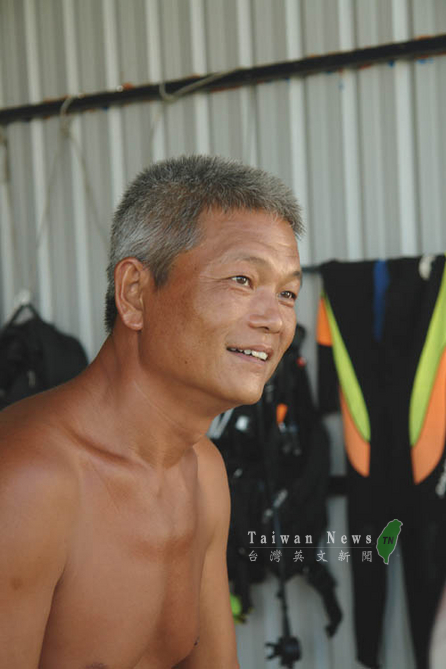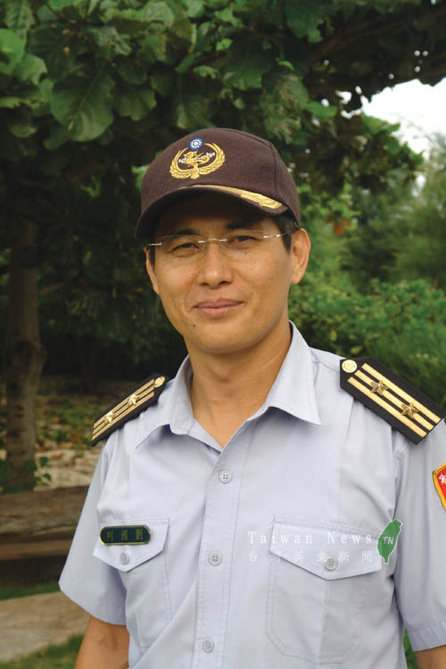Article / Taiwan News Nancy T. Lu
Dongsha from the air is a stunning jewel rising from the blue and green waters of the South China Sea.
The coral reef enclosing a lagoon, a protected area known today as the Dongsha Marine National Park, holds promise of a perfect getaway from the stressful city life. White sandy beach, seen through the window of a plane moments before touchdown, stretches around a part of the tranquil island haven in the sun.
To visitors arriving in Dongsha for a very brief stay, the story about the coral spawning and bloom millions of years ago to create this wonderful natural habitat for flora and fauna fascinates. Time spent there, in fact, is full of moments of reflection on what life is all about, what is absolutely necessary in life and what is superfluous.
Soft and hard corals of many shapes in the waters of the Dongsha Atoll, a breathtaking sight not open to tourism, remain colorful only for as long as their symbiotic relationship with the algae living within them remains in place. Coral branches washed ashore by the waves from time to time, in fact, show bleaching due to stress. Disease, excess shade, pollution, salinity changes (rain), and mainly the increased water temperature affect the beautiful coral colonies.
About six years ago, experienced diver Kuo Tao-jen went down to have a look and his heart broke to find whole dive areas covered with dead corals. Sea temperature anomalies brought on by El Ni?o in 1997-1998 had something to do with the demise of the reefs, he said. In August this year, he returned to do more documentary filming for the Public Television Service Foundation and the Construction and Planning Agency under the Ministry of Interior. He was very excited to see patches of recovering corals. 
Coral reefs as learned from the books are the most productive natural communities on earth, found usually in clear, shallow waters. Dongsha's reefs, a good example, provide food and habitat for fish and other marine life, making each dive in the now restricted area a thrilling experience for researchers. Even the servicemen trained to dive have few opportunities to go into the water these days. Nature must be protected.
Kuo likes to chase the creatures of the undersea fairy garden, seeking to interact in a friendly way with them. But farther out in the South China Sea, where the coral beds are the most beautiful, the approach of divers automatically sends the schools of fish fleeing in panic.
Unsustainable fishing practices in the past wiped out the bounty of the sea, ruining the ecosystem. The fishermen on boats from China, Vietnam, Hong Kong, and the Philippines in recent years resorted to the use of gill nets, long lines, purse seines, and even dynamite and cyanide to catch fish in the area along the sea and trade routes dating back to the Han Dynasty. They also dumped mercury batteries in the water.
The Coast Guard now sends out patrol boats to warn trespassers about their illegal fishing practices. The men in uniform are constantly amazed to see how ingenious albeit crude these fishermen could be in their deadly fishing devices.
The trauma inflicted on the marine life is long-lasting. According to Kuo, a Japanese research found that fish have long memories - in fact, as long as 50 years. Man, after destroying the ecological balance in nature, must now try to win back the trust of the creatures of the waters. It will definitely take time to befriend the fish again and erase the ugly memories.
Sea turtles used to crawl ashore after swimming a long distance to lay their eggs and then bury them in the sand. But Dongsha during the Japanese colonial days ceased to be a safe and suitable place for female turtles to leave their eggs.
Cuthbert Collingwood, a naturalist, wrote down his impressions of the Pratas Island (former name of Dongsha) after a one-day visit in 1866. He described seeing hundreds of birds on the horseshoe-shaped island. Returning researchers in recent years have not been able to spot and document such huge flocks of birds again.
Archaeological findings on the island have included buried feathers of birds and stony shells of sea reptiles. Records indicate Japanese interest in Dongsha from 1907 to 1909 mainly because of resources like the phosphorus mine and birds.
The phosphorus mineral on the island was traced to bird droppings. The feathered species, which were attracted to Dongsha by food, could not digest the phosphorus in the fish, which they caught and ate. Over time, the discharged droppings accumulated, creating a mine rich in phosphorus.
The birds themselves were coveted for their feathers, which found their way to the fashion capitals of the world like Paris.
The bird count on Dongsha island today has dropped sharply. The atoll, however, continues to be a stop along the route taken by the migratory birds such as swallows, egrets, and herons, among others, because the sea grass beds yield food season after season.
Strolls along the shoreline today lead to never-ending discoveries about the atoll's ecology. Changing tides expose the baby sharks combing the underwater sea grass beds for fish, spotted darting here and there. Powdery white sands - each grain a seashell - cover the beach that is a dream retreat for those who must earn a living in a city like Taipei. But resist any temptation to bring home white sands in bottles. It is forbidden.
Holes left gaping along the coast in the daytime mark out the presence of crustaceans and mollusks. Pulling out a peeping animal by force entails the risk of pain from the grip of pincers.
Return at night and catch countless hermit crabs having a party under the moonlight. They crawl all over the place with their salvaged empty seashells on their backs, searching for food. All that are left on the sandy shore the following morning are what seem like crisscrossing tank trails.
When on Dongsha island, race down a bike trail and even the entire airport runway at the end of the day to catch the dramatic sunset from a vantage point. The next morning, rise early from bed to chase the awe-inspiring glow of dawn from the seaside. White, puffy clouds constantly changing shape in the big, blue sky are mirrored like a painting on the calm lagoon in the early morning. 
Breakfast with the servicemen includes bread baked in the kitchen on the island. In the morning, right after breakfast, men on duty at the Meteorological Station release a weather balloon to gauge the temperatures at different altitudes as well as the wind velocity.
The Uni-Air plane, which flies in about 56 passengers every Thursday, also regularly delivers food supplies like meat, fish, vegetables and fruits. Cargo comes in by sea, too, once a month.
A harbor capable of handling a ship with 20-ton cargo has yet to be built. Project bidding will take place before the end of the year, said Dongsha Commander Liu Kuo-lieh. Construction requires a 15-month period, added the Coast Guard officer with strong engineering background.
"Typhoon Pearl's visit last year has proved so far to be my most unforgettable experience here in Dongsha," Liu said. " For 19 hours, the typhoon kept turning and swirling over the atoll, refusing to go away."
The typhoon brought heavy rains. The dike on one side of the island was destroyed, causing the water to rush in during high tide. The airport next to the lagoon remained under water for sometime. The debris left by the typhoon took a while to clean up.
Fishermen in the vicinity at that time sought refuge in Dongsha's waters. An invitation for them to come ashore was turned down because they did not want to abandon their boats

:::
Return
TOPICS
Dongsha Atoll: Protected for a better tomorrow
Last Updated: 2009-08-11
Published: 2009-08-10

![Text size [Small]](/media/system/images/font_small.jpg)
![Text size [Medium]](/media/system/images/font_normal.jpg)
![Text size [Large]](/media/system/images/font_big.jpg)





